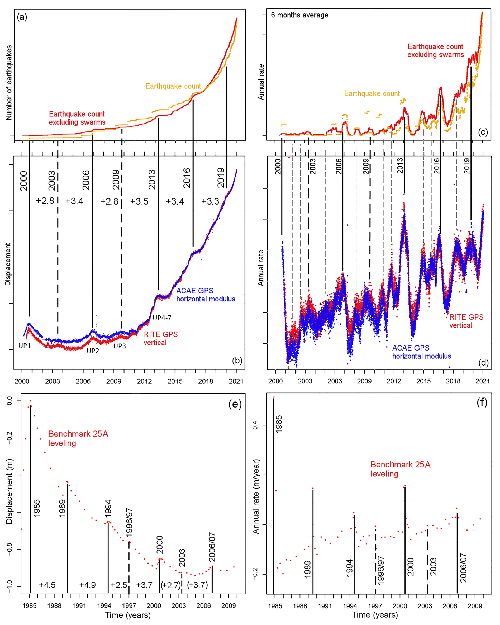Data analysis of the unsteadily accelerating GPS and seismic records at Campi Flegrei caldera from 2000 to 2020

Bevilacqua A., P. De Martino, F. Giudicepietro, P. Ricciolino, A. Patra, E.B. Pitman, M. Bursik, B. Voight, F. Flandoli, G. Macedonio, A. Neri (2022).
Nature – Scientific reports, 12, https://doi.org/10.1038/s41598-022-23628-5
Abstract
Ongoing resurgence affects Campi Flegrei caldera (Italy) via bradyseism, i.e. a series of ground deformation episodes accompanied by increases in shallow seismicity. In this study, we perform a mathematical analysis of the GPS and seismic data in the instrumental catalogs from 2000 to 2020, and a comparison of them to the preceding data from 1983 to 1999. We clearly identify and characterize two overlying trends, i.e. a decennial-like acceleration and cyclic oscillations with various periods. In particular, we show that all the signals have been accelerating since 2005, and 90–97% of their increase has occurred since 2011, 40–80% since 2018. Nevertheless, the seismic and ground deformation signals evolved differently—the seismic count increased faster than the GPS data since 2011, and even more so since 2015, growing faster than an exponential function The ground deformation has a linearized rate slope, i.e. acceleration, of 0.6 cm/yr2 and 0.3 cm/yr2 from 2000 to 2020, respectively for the vertical (RITE GPS) and the horizontal (ACAE GPS) components. In addition, all annual rates show alternating speed-ups and slow-downs, consistent between the signals. We find seven major rate maxima since 2000, one every 2.8–3.5 years, with secondary maxima at fractions of the intervals. A cycle with longer period of 6.5–9 years is also identified. Finally, we apply the probabilistic failure forecast method, a nonlinear regression that calculates the theoretical time limit of the signals going to infinity (interpreted here as a critical state potentially reached by the volcano), conditional on the continuation of the observed nonlinear accelerations. Since 2000, we perform a retrospective analysis of the temporal evolution of these forecasts which highlight the periods of more intense acceleration. The failure forecast method applied on the seismic count from 2001 to 2020 produces upper time limits of [0, 3, 11] years (corresponding to the 5th, 50th and 95th percentiles, respectively), significantly shorter than those based on the GPS data, e.g. [0, 6, 21] years. Such estimates, only valid under the model assumption of continuation of the ongoing decennial-like acceleration, warn to keep the guard up on the future evolution of Campi Flegrei caldera.


Devi effettuare l'accesso per postare un commento.